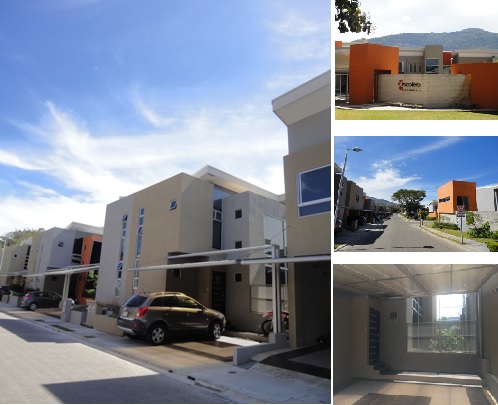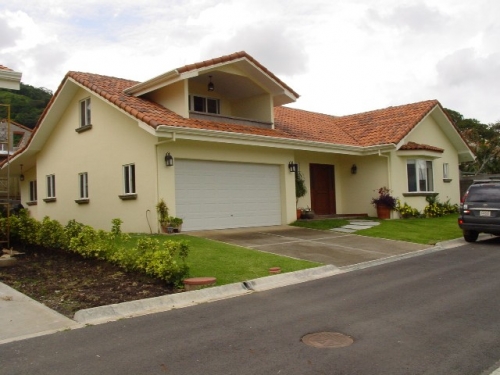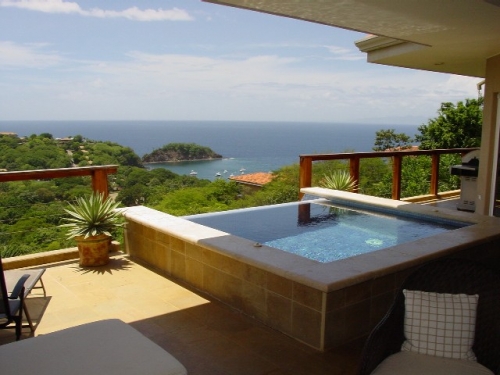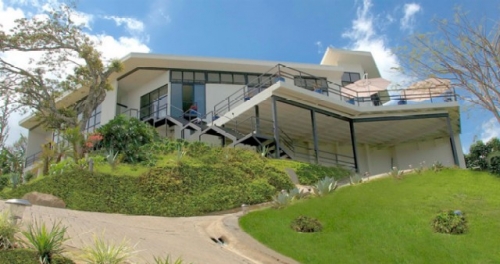Costa Rica Guide
Costa Rica Real Estate
List your property today!
Inclusion of real estate listings at Costa Rica Guide is
absolutely free of charge.
Featured Properties
Costa Rica Guide - Costa Rica Real Estate
Costa Rica Business
1999 General Statistics
- Unemployment rate: 6.0%
- Underemployment rate: 7.8%
- Total labor force: 1,300 thousands
- Economically active population: 40.5%
- Percentage of Total Employed Population by Sex (1998): Men: 69.2%, Women: 30.8%
- Employment by Sectors
| Industry and construction: | 23.1% |
| Commerce and transport: | 26.4% |
| Agriculture and mining: | 19.9% |
| Services: | 30.1% |
Education
Costa Rica has one of the highest literacy rates of the American Continent (95%). The abolishment of the armed forces in 1949 freed resources that have been invested in free education and health services for the population. Education is compulsory until the 9th grade and places strong emphasis on computers and English since early grades.
The National Training Institute (INA) offers free technical training in many fields. Several technical schools and universities prepare professionals with the highest international standards. These institutions offer various degrees in electronic, electric, mechanical, and process engineering. Harvard University has an extension in Costa Rica called INCAE to prepare middle and upper level managers. Today, Costa Ricans manufacture electronic components, computer parts, pharmaceuticals, jewelry, clothing and food products, as well as perform data processing, software development and customer support.
| Expenditure on Education | 6.4* | % of GNP (1999 budget) |
| Average years of Schooling | 6.0 | % of > 25 years |
| Total University Graduates | 17,834 | Average 1996-98; Total graduates |
| Total University Graduates | 0.51% | Average 1996-98; % of Population |
| Industrial Productivity per Laborer | $7,930.00 | US $ per year |
| Sources: World Bank, IADB database,
CONES, CONARE, ETM/OIT, San Jose * A 1997 Law fixes education expenditures at 6% of GDP |
||
Estimated Supply and Demand for Engineers and Technicians in Costa Rica in Selected Fields*
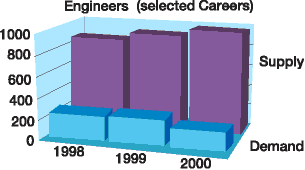
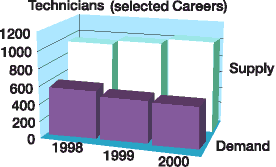
* Selected Fields include Electricity, Electronics, Mechanics, Computer Sciences, Industrial Production, etc.
Labor Productivity
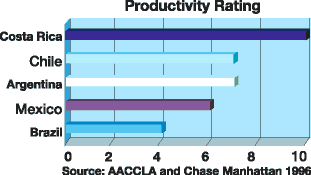
Labor Regulations
The Costa Rican Labor Code (Codigo de Trabajo) is the legal reference for all labor regulations. According to the Code, "... an employer-employee relationship exists when there is an exchange of services for money and the employer exerts direction and control over the employee's duties..."
The Internal Work Regulations, prepared by the employer, registered, and approved by the Ministry of Labor and Social Security, constitute in practice the main regulatory instrument. The Internal Work Regulations, which is mandatory for companies employing large number of employees, incorporate terms and conditions related to almost all labor relationship issues.
The following are some of the main topics covered by law, some of which would be included in the Internal Work Regulations.
Work Schedule
In general terms, the work day or work period shall not exceed 8 hours if the work is executed during the day (5:00 A.M. to 7:00 P.M.), 6 hours if the work is executed during the night (7:00 P.M. to 5:00 A.M.), and 7 hours if the work is executed before 10:30 P.M. The total weekly period shall not exceed 48 hours. Nevertheless, exceptions do apply. For example if the work to be performed is not dangerous or unhealthy, the work period could be of 10 hours during the day and of 8 hours during the night, not exceeding 48 hours per week. Different work periods could be applied under special conditions.
Effective work time will be considered the time in which the employees remain under the immediate or delegated orders or direction of the employer. Two 10-15 minute rest periods per workday are customary. If the working day is continuous and the lunch break does not exceed 30 minutes, it will be considered part of the work period and thus a paid rest.
Administrative workers, general managers, etc. (white-collar workers) are excluded of this limitation of shifts. However, they cannot be forced to work more than 12 hours a day.
Employees have the right to enjoy at least one fixed day of absolute rest during each week, or following six days of continuous work.
Overtime
Payable as time-and-a-half and the workday cannot exceed 12 hours. Overtime is not permitted when the working conditions are dangerous or unhealthy.
Holidays
There are nine legal or payable official holidays. The company can also designate holidays at its discretion. If a worker works on a Holiday or on his day off, the employer will have to pay him double-time. The holidays with mandatory payment are: January 1, April 11, Thursday and Friday of Holy Week, May 1, July 25, August 15, September 15 and December 25.
The days August 2 and October 12 are also holidays, but payment is not mandatory. If they fall on Tuesday, Wednesday, Thursday or Friday, the holiday may be enjoyed on the next Monday.
Wages / Payment
Minimum wages are adjusted by the National Salary Council (made up of representatives from the labor force, of employers and of the Government) twice a year based on the inflation index. Payment is by time period or unit/piece work. The company is free to determine method and timing of payment. Blue-collar workers are paid weekly or twice a month; white collar and domestic workers, monthly.
Paid Vacations
The worker is entitled to a minimum of two weeks of paid vacations for every 50 weeks of continuous activity under the same employer. If terminated before accumulating those 50 weeks of employment, the employee is entitled to one vacation day per each month worked. If a worker has acquired a right to vacations and he ceases in his work for any cause before enjoying them, he will be paid the corresponding amount. This is the only case in which vacations are allowed to be compensated with money.
The employer has the capacity to change the two weeks to a scaling system of vacations according to the time worked by the employee or any other system that results in higher benefits for the employees. The employer will establish the season in which the employee can enjoy his vacation, but this must be done within the fifteen weeks following the day in which fifty weeks of continuous service are reached.
The employees will have an uninterrupted vacation period. Eventually, it may be divided into a maximum of two periods, provided there is an agreement between the parties. As a rule, the Labor Code does not allow employees to accumulate vacation time, except in cases when the employee carries out technical or confidential tasks that make his replacement difficult.
Trial period
In every labor contract or relation for an indefinite term, there will be a three month trial period. The company can decide not to hire the individual during those three months and not incur in any responsibility other than the payment of vacations (one day per month) and the Christmas bonus. After the three-month trial period, it is assumed that the company has hired the individual and all provisions of the Labor Code are in force, for both the company and the employee.
Social Security benefits
Costa Rica has a mandatory social security system that provides all citizens with medical care, disability payments, and retirement benefits. The employer acts as a collector of deductions made on the employees' salary. Costs are calculated as a percentage of the worker's salary.
The employer must pay the following as a percentage of the payroll:
| Health and Maternity: | 9.25% |
| Disability, old age and death benefits: | 4.75% |
| Family Allowances (Welfare benefits) | 5.00% |
| INA - National Training Institute Tax | 2.00% |
| IMAS - Social Assistance Tax | 0.50% |
| Workmen's Savings Bank | 0.50% |
| Labor Accident Insurance | 1.9% to 5% |
| Total employer contribution: | 23.9% to 27% |
Note: There is new Workers Protection Law, which will change (possibly in January 2001) the distribution of the contributions, but will not affect the total cost.
Sick Leave
The sick leave is payable by the employer at 50% of salary for the first 3 days. From the fourth day on, Social Security pays 60%. Maternity leave is payable at the same 50% rate for 4 months (120 days: 30 days before and 90 days after birth), while Social Security covers the remaining 50%. In case of absence by injury or accident, the National Insurance Institute covers 75% of the injured worker's salary without time limitation from the first day.
Christmas Bonus
It is mandatory to pay a "Christmas Bonus", which equals one twelfth of the ordinary and extraordinary salaries received during the twelve months prior to November 30 of each year (or during the months worked). It has to be paid within the first 20 days of December. In case of a termination of the work agreement before the end of the corresponding term, the bonus must be paid proportionally and immediately.
Reserve Provisions
The Law suggests that employers should keep reserves for the payment of:
| Vacations | 3.85% |
| Christmas Bonus | 8.33% |
| Holidays | 2.47% |
| Severance* | 8.33% |
* The severance provision will change with the new Workers Protection Law: 3% will become a mandatory contribution, while 5.33% will continue as at present.
Termination of work relationship
If an employee's dismissal is due to a justified cause (as set forth in the Labor Code) then the employer will only be liable for the payment of wages, proportional vacation time and Christmas Bonus. The dismissal must be well substantiated in case the employee should file a complaint. All disciplinary actions must be taken within 30 days of the action.
The following are "just causes" for ending an employer-employee relationship:
- Physical or moral acts or libel committed against another worker or employer during working hours and outside working hours.
- Criminal acts or property damage.
- Acts that endanger security and working conditions.
- Release of confidential information.
- Unjustified absence for 2 consecutive days or 3 or more days.
- Disobeying instructions or orders.
In case of dismissal without "just cause", the employer must give dismissal notice and severance payment, proportional to the total time worked by the employee.
On the other hand, some reasons justify employees to resign while retaining their right to demand severance payments. These reasons are:
- Nonpayment of agreed salary. Dangerous working conditions or contagious diseases in the work place.
- Moral or physical damage, or defamation against worker by the employer or his representatives during or after working hours.
- On purpose damage to worker's tools by employer.
The following are a set of financial obligations that the employer must fulfill if the employee is dismissed without mediating a "just cause" or if he resigns for one of the reasons stated above:
Pre Termination Notice (Pre Aviso)
Before an employer can dismiss an employee without cause, he/she must notify the individual. Failure to do so will trigger additional obligations. The amount of notice required depends on the length of time that the employee has worked for that particular employer. If the period is greater than three months but less than six months, he is entitled to one week notice of termination; six months to one year: two weeks notice; more than one year: one month prior notice. Instead of written notice, the employer can pay the employee a sum of money equivalent to the salary that would have been earned during the notice period. (The same is effective if the employee decides to leave voluntarily. If previous notice is not given, the same period will be deducted from the vacations and Christmas bonus).
Severance Pay (Cesantia)
If the employer dismisses an employee without cause or if the employee quits for a cause attributable to the employer, he/she is entitled to severance pay. This payment works as a built-in unemployment compensation system. The employer is to subsidize the employee while he/she searches for another employment. The Code states that severance pay should be calculated according to the average salary of the previous six months and in accordance to the period labored as follows (The severance pay will change with the new Law, although total cost for employers will not be significantly altered):
- More than three months but less than six months: ten days wage.
- Six months to one year: twenty (20) days' wage.
- More than one year: thirty days wage for every year labored up to a maximum of 8 months.
Accumulated Vacation Pay
When an employee is dismissed, any unused vacation time must be paid. The amount is determined by multiplying the employee's daily (gross) wage by the unused vacation days.
Injuries on the job/workers compensation insurance
The Labor Code establishes guidelines to provide workers with occupational health and safety. Laws that cover worker compensation were expanded in 1982 and incorporated into the Labor Code.
Every employer must have worker's compensation insurance to protect workers from accidents. The National Insurance Institute (Instituto Nacional de Seguros) sells the worker's compensation policy. The employer may also be responsible for independent contractors if they are under his direction. If a worker is injured and the employer does not obtain insurance as required, the employer will be liable for all expenses incurred by the worker as result of the injury. Municipal inspectors from the National Insurance Institute verify that all employers have worker's compensation insurance. Certified inspectors may shut down any business that violates these provisions.
Once an injury occurs on the job, the employer is responsible for filing a Notice of Injury Form at the National Insurance Institute, within eight days of occurrence. The injured worker has a right to claim a benefit for all medical services and rehabilitation incurred as a result of the injury, as well as the payment of 75% of his/her salary.
Foreign employees
A migratory system (company visa) was created for those companies operating under the Free Zone System. This allows managerial and/or technical staff to work in the plant for determined periods.
Labor costs
Fringe Benefits in Costa Rica
The following is a list of all the mandatory fringe benefits for employees in Costa Rica, expressed as a monthly percentage of the salary.
| MANDATORY BENEFITS | EMPLOYER CONTRIBUTION | EMPLOYEE CONTRIBUTION |
| Monthly percentages | ||
| Social Security | ||
| Health and Maternity Benefits | 9.25% | 5.50% |
| Disability, Old Age and Death Benefits | 4.75% | 2.50% |
| Family Allowances (Welfare Benefits) | 5.00% | ----- |
| Instituto Nacional de Aprendizaje (INA) (National Training Institute Tax) | 2.00% | ----- |
| Banco Popular y Desarrollo Comunal (Workmen's Obligatory Savings Bank) | 0.50% | 1.00% |
| Instituto Mixto de Ayuda Social (IMAS) (Eradication of Extreme Poverty) | 0.50% | ----- |
| Instituto Nacional de Seguros (INS) (Occupational Hazard Insurance) | From 1.9% to 5% | |
| TOTAL | 23.9% to 27.0% | 9.0% |
| (*) The National Insurance Company has a list of rates based on the employee's category. The Occupational Hazard Insurance is the average of all the company's employee's rates, so it varies according to the company's payroll. However, the range may go from less than 1.9% (in few cases) to 5%. | ||
Note: There is new Workers Protection Law, which will change (possibly in January 2001) the distribution of the contributions, but will not affect the total cost.
Additional costs:
There is a Christmas bonus of one month's salary that must be paid in December. The Law suggests that companies should keep the following reserves (**):
Vacations: 3.85%
Holidays: 2.47%
Severance: 8.33% This
provision will change with the new Workers Protection Law: 3% will
become a mandatory contribution, while 5.33% will continue as at
present.
(**) Annual or proportional. Savings provisions are recommended for financing these remunerations.
Minimum Wages
The following is a list of the Minimum Wages for the Private Sector, applicable from July 1 until December 31, 2000.
| Job Description | Minimum Wages in Colones | Minimum wages in U.S. $ | |||
| Present rate: 308.32/$ | Year-end rate: 323.73/$ | Per hour estimation | Fully loaded, per hour estimation | ||
| Monthly Wages | |||||
| Non-qualified worker | 73,295 | 237.73 | 226.41 | 1.10 | 1.62 |
| Semi-qualified worker | 79,534 | 257.96 | 245.68 | 1.19 | 1.75 |
| Qualified worker | 85,446 | 277.14 | 263.94 | 1.28 | 1.88 |
| High School level technicians | 92,038 | 298.52 | 284.30 | 1.38 | 2.03 |
| Specialized worker | 98,631 | 319.90 | 304.67 | 1.48 | 2.18 |
| College Technicians | 113,427 | 367.89 | 350.37 | 1.70 | 2.50 |
| Bachelor Degree (University) | 138,951 | 450.68 | 429.21 | 2.09 | 3.06 |
| "Licenciatura" Degree | 166,747 | 540.83 | 515.08 | 2.50 | 3.68 |
| Daily Wages | |||||
| Non-qualified worker | 2,444 | 7.93 | 7.55 | 0.94 | 1.39 |
| Semi-qualified worker | 2,685 | 8.71 | 8.29 | 1.04 | 1.52 |
| Qualified worker | 2,803 | 9.09 | 8.66 | 1.08 | 1.59 |
| Specialized worker | 3,368 | 10.92 | 10.40 | 1.30 | 1.91 |
| Source: Official Periodical
La Gaceta, no. 117, Alcance 42, June 19, 2000 * Generics ** Daily wages are considered possible for the following sectors: Agriculture, Mining, Manufacturing, Industry, Construction, Electricity, Trading, Tourism, Services, Transportation and Storage (a) Estimated rate by July 1, 2000: 308.32 colones / $1. (b) Estimated rate by Year end 2000: 323.73 colones / $1. (c) Estimated salary per worked hour (year-end rate), with 8 hour workdays and 6 day weeks. (d) Estimated fully loaded salary per worked hour (June-end rate): 23.9% fringe benefits, 8.33% Christmas bonus, 8.33% severance, 3.85% vacations and 2.47% for holidays. |
|||||
Average Market Salaries
AVERAGE SALARIES IN MANUFACTURING AND SERVICE COMPANIES IN COSTA RICA (Wages in U.S. $)
| OCCUPATION | AVERAGE PER MONTH | AVERAGE + FRINGE BNFTS. (1) | FULLY LOADED COST (2) | ANNUAL COST (Thousands) |
| General Manager | 8,371 | 10,372 | 12,089 | 145.1 |
| Administrative & Financial Mgr. | 4,229 | 5,240 | 6,107 | 73.3 |
| Human Resources Manager | 3,748 | 4,643 | 5,412 | 64.9 |
| IT Engineer / System Programmer | 1,505 | 1,865 | 2,174 | 26.1 |
| General Accountant (Chief) | 1,345 | 1,666 | 1,942 | 23.3 |
| Technical Support for IT / Computer Systems | 815 | 1,010 | 1,177 | 14.1 |
| Accountant Assistant | 595 | 737 | 859 | 10.3 |
| Secretary (bilingual) | 638 | 791 | 922 | 11.1 |
| Bilingual Receptionist | 410 | 508 | 592 | 7.1 |
| Messenger | 381 | 472 | 550 | 6.6 |
| Janitor | 285 | 354 | 412 | 4.9 |
| Manufacturing Companies | ||||
| Production Manager | 4,186 | 5,187 | 6,046 | 72.5 |
| Quality Control Manager | 4,024 | 4,985 | 5,811 | 69.7 |
| Plant Manager | 3,257 | 4,035 | 4,703 | 56.4 |
| Quality Control Supervisor | 1,128 | 1,397 | 1,629 | 19.5 |
| Plant / Process Engineer | 1,125 | 1,393 | 1,624 | 19.5 |
| Production Supervisor | 764 | 946 | 1,103 | 13.2 |
| Mechanic/Electrician (Maintenance) | 520 | 644 | 751 | 9.0 |
| Specialized worker | 387 | 479 | 559 | 6.7 |
| Semi-qualified worker | 322 | 399 | 465 | 5.6 |
| Non-qualified worker | 289 | 358 | 418 | 5.0 |
| General production assistant | 260 | 322 | 376 | 4.5 |
| Service Companies | ||||
| Customer Service / Operations Mgr. | 3,237 | 4,011 | 4,675 | 56.1 |
| Customer Service Chief | 1,043 | 1,293 | 1,507 | 18.1 |
| Telemarketing Agent (In Charge) | 608 | 753 | 878 | 10.5 |
| Customer Service Agent | 595 | 737 | 859 | 10.3 |
| Sales Agent | 1092 | 1,353 | 1,577 | 18.9 |
| Source: Consulting
Companies. Surveys for first semester 2000. Exchange rate for calculations: 307.67 colones / U.S. $ (rate for June 19, 2000). |
||||
| (1) Social/medical/fringe benefits and workers compensation insurance: 23.90% | ||||
| (2) Included: Christmas bonus (1month salary) and reserves for vacations (3.85%) and severance (8.33%) | ||||
Incentives for foreign investment
Costa Rica has taken an active stance in attracting foreign investment since the beginning of the eighties, Costa Rica was the first country in Central America to make a conscious effort to attract direct foreign investment. Different incentive programs were enacted at the time as well as promotional programs to position Costa Rica internationally.
Under Costa Rica's legal framework, there are no performance requirements or minimum investment levels for foreign investors in any activity.
Investment incentives are available for activities directly related to the export of services and/or products from Costa Rica. These incentives are: the Free Zone system, the Continuous Product Development program and the Duty Reimbursement program, each one regulated by its own legal framework.
All countries agreed with WTO (World Trade Organization) to eliminate some of the incentives given to exporters and investors in the year 2003. CINDE and the Government of Costa Rica are working to increase the competitiveness of the country and offer alternative incentives allowed by the WTO to actual and future investors.
Free Zone System
The Free Zone System (export processing zones) is the mainstay of Costa Rica's export and investment promotion strategy.
The Free Zones are, by definition, areas of customs and fiscal extra-territoriality. These facilities have been designated to carry on operations based on importing raw materials, manufacturing, assembly and marketing of products or services for export.
Tax exemption, ease of operation and monetary exchange, excellent telecommunications, public service infrastructure and basic service facilities constitute the cornerstone of development for the companies that operate under the Free Zone Regulations. To be eligible for Free Zone Status, companies must make an initial investment of at least US$ 150,000 in an Industrial Park or US$ 2,000,000 outside an Industrial Park.
This system allows companies to enjoy the widest range of benefits currently available in the country. Among the fiscal benefits granted under the provisions of the Free Zone legislation are: 1/
- 100% exemption from import duties on raw materials, parts and components;
- 100% exemption on taxes on profits for 8 years, and 50% for the following 4 years;
- One to four years of 75% exemption on taxes on profits in case of reinvestment;
- Exemption from taxes on remittances abroad;
- 100% exemption from export taxes;
- 100% exemption from sales tax on local purchases of goods and services.
- 100% exemption on capital taxes;
- Possibility to sell to exporters within Costa Rica;
- Possibility to sell up to 25% in the local market.
Operational incentives such as on-site and expedite customs clearance are available.
Location in less developed areas of the country, such as the port city of Puntarenas, insures additional incentives:
- 100% exemption of taxes on profits for 12 years and 50% for the following 6 years.
- Job bonus: 5 year Government partial payback of net payroll, starting at 10% and decreasing at 2% per year.
- Subsidized training program: the Government of Costa Rica will pay every new direct worker for up to six months while receiving free on-site training, provided by the National Training Institute.
Most of the parks are located near San Jose, with the exception of Puntarenas Free Zone, which is located close to the main port on the Pacific Coast, approximately 65 miles from San Jose. These industrial parks can accommodate anything from the simplest to the most sophisticated building requirements of companies within the highest standards of construction (Costa Rican building standards meet and usually exceed U.S. codes).
There are twelve Free Trade Zone Parks in operation in Costa Rica.
Continuous Product Development
The Continuous Product Development program allows the exporter to import, tax free, all machinery, equipment, raw materials and semi-elaborated products necessary for the production process. This program has two chapters:
- Full re-export: Companies subscribing to this program can bypass all taxes on production inputs, provided their total output is re-exported. Once inside Costa Rica, the materials can be processed, repaired, assembled, incorporated into other products and finally re-exported. Customs procedures have also been streamlined so the materials can be transported directly from the port or airport to the company, if the importer has previously presented the necessary documents, reducing the waiting time and the risk of merchandise loss.
- Re-export and Central American or local sale: This chapter allows companies selling part of their production in local or Central American markets to have access to export incentives. Although inputs for re-export remain duty free, full tariffs and domestic taxes must be paid for the portion of exportable output that is retained for sale in the local market. Regional tariffs must also be paid for products exported within Central America.
Reimbursement of Duties
The Reimbursement of Duties incentive program is an addendum to the General Customs Law. Beneficiaries are reimbursed for taxes paid on inputs such as containers, packaging, crates and other similar inputs incorporated into export products. Excluded from this program are products used in processes that modify their nature (transformation, elaboration, combination, mixture, etc.) or when they are used in the commercial transport or manipulation of the finished goods. Machinery and equipment are also excluded from this program.
Reimbursement must be requested within a twelve-month period. Exporters must guarantee customs authorities that inputs, containers, packaging and crates were indeed exported as part of the final product.
Export Incentives by System 1/
| INCENTIVES | FREE ZONE SYSTEM | CONTINUOUS PRODUCT DEVELOPMENT PROGRAM (ACTIVE FINISHING REGIME) | REIMBURSE-MENT OF DUTIES PROGRAM | |
| FULL RE-EXPORT | PARTIAL RE-EXPORT | |||
| IMPORT DUTIES ON RAW MATERIALS, COMPONENTS, PACKAGING, MACHINERY AND EQUIPMENT USED IN PRODUCTION PROCESS. | 100% exemption | 100% exemption | 100% exemption on re-exported portion. Must pay duties on products for local or Central American sale | Reimbursement of duties paid for packaging, containers and similar inputs |
| TAXES ON PROFITS | According to location and reinvestment (See table 1) | Full rate | Full rate | |
| EXPORT TAXES | 100% exemption | 100% exemption | Exemption proportional to export sales | Full rate |
| SALES AND EXCISE TAXES ON LOCAL PURCHASES | 100% exemption | Full rate | Full rate | |
| CAPITAL TAXES | 100% exemption for 10 years | Full rate | Full rate | |
| REAL ESTATE PROPERTY TAX (only for owners) | 0.25%* | 0.25% | 0.25% | |
| TAXES ON PROFIT REPATRIATION | 100% exemption | |||
| CAPITAL REPATRIATION | No restriction | No restriction | No restriction | |
| MANAGEMENT OF FOREIGN CURRENCY | Free | |||
| CUSTOMS SERVICE | Expedited on site | Streamlined procedures | Normal procedure | |
| SALES TO EXPORTERS WITHIN COSTA RICA | Yes | Not allowed | ||
| SALES TO LOCAL MARKET | Up to 25% of production ** | Not allowed | Allowed. Must pay duties. | Allowed. Must pay duties. |
| TIME LIMITATION | Indefinite | 6 months
for raw materials, packaging, etc.
5 years for machinery, equipment, etc. |
Reimbursement must be requested within 12 months | |
| ELIGIBILITY REQUIREMENTS / PROCEDURES | Initial investment of at least US$ 150,000 in an Industrial Park or US$ 2,000,000 outside an Industrial Park. Product must undergo substantial transformation to qualify for incentives ***. | Present application to PROCOMER Operation Manager. Registration in Customs General Directorate | Registration in Customs General Directorate | |
| EXEMPTION OF IMPORT DUTIES ON VEHICLES | 100% exemption: trucks and chassis for trucks; 1-2 ton pick ups; and vehicles for more than 15 passengers | Not applicable | Not applicable | |
| TRAINING ASSISTANCE THROUGH INA (National Training Institute) | Request to Free Zone Administrator. In less developed communities, 3 - 6 month subsidy for trainee wages | Available through normal INA procedures | Available through normal INA procedures | |
| LEGAL BASIS | Law #7210 Nov/23/90
Law #7293 Mar/31/92 Law #7467 Dec/20/94 Law #7638 Oct/30/96 Law #7830 Oct/8/98 |
General
Customs Law (art.179-186) Nov/8/95
Regulations to the General Customs Law (art. 496-509) Jun/28/96 Decree # 26285 H-COMEX Aug/19/97 |
General Customs Law (art.190-191) Nov/8/95 | |
| * 10-year exemption for companies established before June 19, 1995. | ||||
| ** Except for Export traders. Service Companies may sell up to 50% in the local market. | ||||
*** Beneficiaries according to the Law:
1/
|
||||
Different incentives according to location
| Non Designated
Areas (Communities With Greater Relative Development) |
Designated Areas (Communities With Less Relative Development) |
|
| Taxes on profits* | ||
| Initial investment | 100% exemption
for 8 years 50% for another 4 years |
100% exemption
for 12 years 50% for another 6 years |
| Reinvestment during years 4 to 8 | 75% exemption for 1 to 4 years (years 9 to 13), according to reinvestment amount. | 75% exemption for 1 to 4 years (years 13 to 17), according to reinvestment amount. |
| Job bonus | ||
| Percentage of net payroll paid back by Government | 5 years of job bonus, equal to 10% of the net payroll during the first year and decreasing 2% per year. | |
* These exemptions do not include export traders (commercial export companies)
Free Zone Parks Availability and Cost
Current Prices in Free Zone Industrial Parks
| Minimum | Maximum | |
| Rent per square meter per month | ||
| Industrial Space | $3.50 | $5.00 |
| Industrial Offices | $4.50 | $12.00 |
| Corporate Offices | $12.00 | $18.00 |
| Rent per square foot per year | ||
| Industrial Space | $3.90 | $5.57 |
| Industrial Offices | $5.02 | $13.38 |
| Corporate Offices | $13.38 | $20.07 |
| Source: AZOFRAS, from information given by Park Managers | ||
Available Space in Free Zone Industrial Parks
| Free Zone Parks | Buildings | Area for Construction | Comments | ||
| m2 | sq.ft. | m2 | sq.ft. | ||
| Conair, Turrialba | N.A. | N.A. | 198,350 | 2,135,013 | Availability for clients will be defined in the future. |
| Forum (Inm.Genesis) | N.A. | N.A. | 3,000 | 32,292 | No buildings in stock. Custom-built for each client |
| Global Park | 3,000 | 32,292 | 100,000 | 1,076,387 | Usual procedure is to custom-build for each client |
| Inversiones Zeta Cartago | 1,350 | 14,531 | 15,000 | 161,458 | Three 450 m2 (4,844 sq.ft.) buildings which will be ready approximately in June 2001 |
| Inversiones Zeta La Valencia | 800 | 8,611 | 3,000 | 32,292 | Buildings in condominium which will be ready approximately in June 2000 |
| Inversiones Zeta Montecillos | 2,870 | 30,892 | 8,000 | 86,111 | Two warehouses: 1500 m2 (16,146 sq.ft.) and 1370 m2 (14,746 sq.ft.) |
| Los Arallanes (America) | 4,070 | 43,809 | 5,000 | 53,819 | Only two buildings in stock. Buildings are usually custom-built for each client |
| Metrozone | 2,500 | 26,910 | 6,500 | 69,965 | 2000 m2 (21,528 sq.ft.) in warehouses, 500 m2 (5,382 sq.ft.) in offices |
| Saret Alajuela | 2,685 | 28,901 | N.A. | N.A. | One 1800 m2 (19,375 sq.ft.) building without divisions, and 840 m2 (9,042 sq.ft.) in offices |
| Saret Puntarenas | Information pending | ||||
| Ultrapark | 2,600 | 27,986 | 10,000 | 107,639 | Buildings will be ready approximately in July 2000 |
| Source: AZOFRAS, from information given by Park Managers | |||||
1/ All countries agreed with WTO (World Trade Organization) to eliminate some of the incentives given to exporters and investors in the year 2003. CINDE and the Government of Costa Rica are working to increase the competitiveness of the country and offer alternative incentives allowed by the WTO to actual and future investors.
Infrastructure
Costa Rica has one of the most advanced infrastructures in the Caribbean Basin, particularly with regards to a highly reliable electric energy supply and a modern telecommunications network. The latter includes direct dialing to any part of the world, cellular telephone systems, data transmission and facsimile facilities, using both satellite and microwave links.
Given the abundance of water, most electricity is generated from hydroelectric sources and is supplied at 110 volts, 60 cycles, or at the requested voltage by a particular company. Rates for industrial operations are between $0.05 to $0.09 per Kwh depending on location.
A state of the art fiber optic network telecommunications system is in place for the Grand Metropolitan Area (all industrial parks in the San Jose metropolitan area are serviced by the network); there is direct dialing to every country, computerized packet switching, frame relay and dedicated satellite lines for voice, data and video transmission. ISDN capabilities are available.
The reliable supply of oil and its by-products satisfies all industries' internal combustion and transportation requirements.
Well-maintained highways and roads connect the country from coast to coast and to the rest of the Americas via the Interamerican Highway.
There are two international airports, one in San Jose, through which all air freight is exported and one in the city of Liberia in the northwestern part of the country, catering exclusively to tourism. The Juan Santamaria International Airport has been upgraded and equipped to service the needs of demanding import/export operations. It is serviced by 19 passenger airlines (some of which are also cargo carriers) and by 12 air cargo airlines.
There are direct flights to the following cities: Panama City; Managua; San Salvador; Guatemala City; Tegucigalpa and San Pedro Sula in Honduras; Belize; Mexico City; San Juan, Puerto Rico; Santo Domingo, Dominican Republic; Bogota, Medellin, Cali and Cartagena in Colombia; Caracas, Venezuela; Santiago, Chile; Quito, Ecuador; Lima, Per�; Rio de Janeiro; Amsterdam; Dusseldorf , Munich; and Madrid.
In the U.S.: Dallas, Houston, Los Angeles, San Francisco, Miami, Orlando, Atlanta, New York, Washington and New Orleans.
Costa Rica has one main port on each coast, on the Caribbean and the Pacific, which offer access from Costa Rica to any market in the world. Limon-Moin, on the Caribbean/Atlantic coast, handles approximately 80% of ocean freight exports. Puntarenas-Caldera, on the other hand, is on the Pacific Coast. Overland trucking time from port to port is approximately 6 hours. Well known international carriers such as Sea Land, Maersk, Nedlloyd, Dole Shipping and Seaboard Marine provide transportation services to ports in Central America and the Caribbean, and American ports of entry like Miami, Wilmington, Camden, Houston, New Orleans, Charleston, Savannah, Philadelphia, Bridgeport and Long Beach, California. As a reference, usual transit time to Miami is 5 days.
TELECOMMUNICATION SERVICES RADIOGRAFICA COSTARRICENSE (RACSA)
Operating since 1921, Radiografica Costarricense, S.A. (RACSA) is the government agency responsible for telecommunications. In tune with the times, since 1991 international communication services have been provided by this agency through several earth stations (teleports) linked to Intelsat, AOR 307, Solidaridad II and PAS 1 satellite from PANAMSAT. RACSA works in conjunction with worldwide carriers in the United States and Latin America such as: MCI, AT&T, IDB-WORLDCOM, TELEGLOBE, GUATEL, SATEL, AMERICATEL, PANAMSAT, ATSI, CHARTER.
Services:
RACSA offers a wide variety of services to match specific customer needs. Some of these are:
- Dedicated Internet Access
- Digital point to point links
- Transportation Networks with fiber and wireless digital technology (Frame Relay, TDMA)
- Leased Channels using satellite facilities (RACSASAT)
- VSAT networks
- X.25 networks
Additionally, RACSASAT Teleports offer I.B.S. services and connects its customers point to point by addressing private communication needs. RACSASAT is possible through ground stations located in downtown San Jose, Pavas and industrial parks, all of which are interconnected through Racsa's digital networks. Whenever clients require the service, Racsa connects them to the nearest station through copper or optic fiber cable, or through wireless links. The service is specifically designed to service banks, trans-national corporations, shipping companies, exporters, scientific organizations, government institutions, and any other type of company with a high volume of international communications.
Applications:
The RACSA S.A.T link aids the Costa Rican business sector with applications that include - among others - the following:
- High - and medium - speed data transmission (LAN and information systems interconnection)
- Audio and video teleconferencing
- Corporate e-mail
- Data processing
- Electronic fund transfers
- Remote processing
- 800 remote service
- Remote telemarketing
- Simultaneous applications for voice, data, fax, video, and corporate communications systems.
- Interconnection with corporate Intranets
Benefits:
Satellite transmission of data, voice and video is not limited by time or space. Among RACSASAT's most important advantages are the following:
- Significant savings on telephone calls and fax transmission
- Fixed monthly rates
- Digital network interconnection between subsidiaries and headquarters 24 hours a day, 365 days a year
- Transparent integration of the company's switchboards and equipment when its offices are located in two different countries.
- Premium quality, excellent transmission speed, and reliable technical support service
- Multiple satellite routes (PANAMASAT, INTELSAT and SOLIDARITY II) make the system globally redundant
- Transparent transport of any protocol.
Minimum requirements:
- Local linkage to digital networks, coordinated by RACSA
- A standard physical interface (G703, V.35 or RS.232) in the company's communications equipment (multiplexer or modem)
- The company's terminal voice, fax, or data equipment must be compatible at both ends of the link (switchboard, router, multiplexer, etc.)
The services are offered to more than 35 companies that have been established in Costa Rica among which are:
- Dole Fresh Fruit
- Unisys
- 3M
- Bourns Trimpot
- Hanes-Sara Lee Knits
- Sykes
- Visa
- Intel
- Mastercard
- Espion
- Coca Cola Inter-American
Point of contact:
For information on current rates or details on other services, see "services" at http://www.racsa.co.cr. For specific company needs, quotations or questions, contact:
Negocios Empresariales
Phone: (506) 287- 0603
Fax: (506)
223- 1416
E-mail: negemp@sol.racsa.co.cr
URL: http://www.racsa.co.cr
Electricity
Monthly Electricity Rates for Industrial Use, in U.S. $
| Rate Type | Electricity Distribution Companies | |||
| ICE | CNFL (San Jose) | JASEC (Cartago) | ESPH (Heredia) | |
| Consumption under 3000 KWh | ||||
| Energy charge | ||||
| Each KWh | 0.11 | 0.09 | 0.07 | 0.09 |
| Minimum Rate (First 30 KWh) | 3.19 | 2.78 | 2.70 | |
| Consumption from 3001 to 20 000 KWh | ||||
| Energy charge | ||||
| First 3000 KWh or less | 185.71 | 168.00 | 114.20 | 140.58 |
| Each additional KWh | 0.06 | 0.06 | 0.04 | 0.05 |
| Demand charge (a) | ||||
| First 8 KWh (10 KWh in JASEC and ESPH) or less | 78.14 | 62.12 | 62.13 | 77.56 |
| Each additional KWh | 9.77 | 7.76 | 6.21 | 7.76 |
| Consumption over 20 000 KWh | ||||
| Energy charge | ||||
| First 20 000 KWh or less | 652.40 | 552.83 | 761.61 | 950.96 |
| Each additional KWh | 0.03 | 0.03 | 0.03 | 0.04 |
| Demand charge (a) | ||||
| First 27 KWh (55 KW in ICE and CNFL) or less | 945.58 | 995.29 | 167.74 | 209.42 |
| Each additional KWh up to 40 KWh | -- | -- | 6.21 | 7.76 |
| Each additional KWh | 17.19 | 18.10 | 9.39 | 11.72 |
| Source: Official
Periodical "La Gaceta" Alcance 40 to Number 114, June 14,
2000.
(a) The demand charge is computed over the 15 minutes with highest demand in the month. In each company with a monthly consumption greater than 3000 KWh, the meter includes an indicator of peak demand with 15 minute integration cycles. Note: There is an additional 13% of sales tax on all
industrial rates. Exchange rate in colones per US$ (June
15, 2000): 307.54. |
||||
This is an example of how to calculate electricity rates in Costa Rica.
| A company with Free Zone Status located in Heredia consumes 50,000 KWh per month. |
| Location: First you must decide which rate to use according to the location. Since the company is in Heredia, use the ESPH rates. |
| Energy charge: The company
must pay an energy charge for the first 20,000 KWh and an
additional charge for the remaining 30,000 KWh: 20,000 KWh = $950.96 30,000 KWh = $1178.38 |
| Demand charge: The company
must also pay this charge, which is calculated on the energy
consumed during the peak 15 minutes. For a company consuming
50,000 KWh monthly, this amount should be around 135 KWh.
Nevertheless, it could be much lower. First 27 KW = $209.42 Next 40 KW = $310.20 Last 68 KW = $796.88 |
| Total Cost: The company must pay a total of $3445.85 which adds up to $0.069/KWh. |
High Tension Electricity Rates, in U.S. $
(For Clients Whose Energy Point of Delivery is 138 000 Volts or more)
| Rate Type | Dry Season | Rainy Season | ||||
| Periods | Periods | |||||
| Peak | Low | Night | Peak | Low | Night | |
| Energy Charge | ||||||
| Each kWh | 0.0442 | 0.0237 | 0.0097 | 0.0331 | 0.0088 | 0.0079 |
| Demand Charge | ||||||
| First 1000 KW or less | 8 560 | 8 260 | 3 750 | 6 420 | 3 060 | 3 060 |
| Each additional Kw | 8.56 | 8.26 | 3.75 | 6.42 | 3.06 | 3.06 |
| Source: Official Periodical "La Gaceta" Alcance 40 to No.114, June 14, 2000. | ||||||
| Definitions:
Dry Season: Jan.1 to August 31 (8 months); Rainy Season: Sept. 1 to Dec. 31 (4 months); Periods: |
||||||
| (a) The demand charge is computed as the maximum power consumption measured during the month for each of the three daily periods. | ||||||
| Note: These prices do not include sales tax, nor public street lights cost. | ||||||
Example:
High-tension clients have meters that measure the power (Kw) delivered for each hour of each day. For our example, let's suppose that during November (rainy season), a Company shows the following power consumption during an average day:
| Hours | 0 | 1 | 2 | 3 | 4 | 5 | 6 | 7 | 8 | 9 | 10 |
| Kw | 3700 | 3510 | 3590 | 3480 | 3500 | 4020 | 3930 | 3920 | 3910 | 4350 | 3560 |
| Period | Night | Low | |||||||||
| Hours | 11 | 12 | 13 | 14 | 15 | 16 | 17 | 18 | 19 | 20 | 21 | 22 | 23 |
| Kw | 3520 | 3660 | 4150 | 4430 | 4260 | 4140 | 3770 | 3500 | 3430 | 3510 | 3740 | 3680 | 3740 |
| Period | Peak | Low | Peak | Night | |||||||||
For this company, the maximum power consumption and total energy for each period is:
| Periods | Maximum Power (Kw) | Total Energy (kWh) |
| Peak | 3660 (minimum of 3000 + 660) | 535 942 |
| Low | 4430 (minimum of 3000 + 1430) | 1 109 904 |
| Night | 4020 (minimum of 3000 + 1020) | 1 122 071 |
Rate calculation (rainy season):
| Periods | Demand Charge (power) | Energy Charge |
| Peak | $6 420 (1000 Kw) + 2660 KW * $6.42 = $23 497 | $535 942 kWh * $0.0331 = $17 740 |
| Low | $3 060 (1000 Kw) + 3430 Kw * $3.06 = $13 556 | $1 109 904 kWh * $0.0088 = $9 767 |
| Night | $3 060 (1000 Kw) + 3020 Kw * $3.06 = $12 301 | $1 122 071 kWh * $0.0079 = $8 864 |
| TOTAL | $49 354 | $36 371 |
The total payment for this company during November would be of $85 725 ($49 354 + $36 371). Since the total energy consumption during the month was 2 767 917 kWh, the average rate would be $0.0310/kWh. A similar realistic example for this company during a summer month (higher rates, lower consumption) gives an average rate of $0.0500/kWh, for an annual average of $0.0432/kWh.
Source: Tarifas y Mercado, I.C.E.
For more information, see ICE or CNFL.
Water Rates
Water rates for industrial use, valid from July 14, 1998, in U.S. $.
| CONCEPT | AREA | Rate according to consumption | Fixed Rate * | |
| 0-15 m3 (minimum) | Each additional m3 | |||
| WATER | Metropolitan | 21.52 | 1.28 | 53.47 |
| Urban | 19.38 | 1.15 | 48.13 | |
| Rural | 15.07 | 0.90 | 37.43 | |
| SEWAGE | Metropolitan | 2.58 | 0.15 | 6.42 |
| Urban | 2.32 | 0.15 | 5.77 | |
| Rural | 1.81 | 0.11 | 4.49 | |
| Source: La Gaceta # 135, July
14, 1998 * Users with no water meter
Note: These rates correspond to Acueductos y Alcantarillados (AyA), the main water company. In some areas, water distribution is handled by the local government (municipalidad) instead of AyA. In these cases, rates are different. Exchange rate valid for February 5, 1999 (colones per US$): 274.04 1 m3 = 1000 liters = 35.31 cubic feet = 264.17 gallons |
||||
Telephone Rates
National telephone rates valid since December 24, 1999 in U.S. $
| Service Type | Concept | Initial costs | Monthly costs |
| Residential | |||
| Installation | 54.49 | ||
| Warranty Deposit | 21.47 | ||
| Monthly rate | 4.95 | ||
| Additional pulses | 0.01 | ||
| Commercial (includes Industries) | |||
| Installation | 54.49 | ||
| Warranty Deposit | 34.34 | ||
| Monthly rate | 6.27 | ||
| Additional pulses | 0.01 | ||
| Digital Network for Integrated Services (RDSI) | |||
| Installation of Basic Service: 2 B channels (64 Kbps each) and 1 D channel (16 Kbps) | 54.49 | ||
| Installation of Primary Service: 30 B channels (64 Kbps each) and 1 D channel (16 Kbps) | 75.96 | ||
| Warranty Deposit | |||
| Monthly rate: Basic Service (includes 300 pulses) | 21.80 | ||
| Monthly rate: Primary Service (includes 4500 pulses) | 329.91 | ||
| Additional pulses | 0.01 | ||
| 800 Service (Automatic collect) | |||
| Installation | 54.49 | ||
| Warranty Deposit | 34.34 | ||
| Monthly rate | 33.02 | ||
| Additional pulses | 0.01 | ||
| Cellular | |||
| Cellular line | 82.56 | ||
| Monthly rate | 9.91 | ||
| Additional minute - full rate | 0.10 | ||
| Additional minute - reduced rate | 0.07 | ||
Note: A pulse is equivalent to 90 seconds in the Zone 1 (Example San Jose to San Jose) and its duration diminishes with greater distances. Exchange rate valid on March 20, 2000 (colones per US$): 302.81. |
|||
Source: Official periodical La Gaceta #250 Alcance #105 (December 24, 1999) |
|||
Rate calculation for telephone calls:
From a conventional telephone to a:
| Conventional telephone: | Normal rate: $0.0129/pulse (3.25 colones) |
| Cellular telephone: | Cellular rate |
| International number: | International rate |
Incoming calls to a 800 number from a:
| Conventional telephone: | Normal rate: $0.0129/pulse (3.25 colones) |
| Cellular telephone: | Cellular rate |
| International number: | International rate |
Source: Official periodical La Gaceta # 74 (April 17, 1998)
International telephone rates (MIDA Direct System)
| RATE TYPE | |||
| Reduced | Super-reduced | ||
| SCHEDULE | Monday to Friday, 7:00 AM to 10:00 PM | Monday to Thursday, 10:00 PM to 7:00 AM
(next day)
From Friday 10:00 PM to Monday 7:00 AM Official Holidays |
|
| COST PER MINUTE (US $) ACCORDING TO DESTINATIONS: | |||
| United States, Puerto Rico, Canada and Mexico | 0.55 | 0.50 | |
| Central America and Belize | 7:00 AM to 7:00 PM: 0.40 |
7:00 PM to 10:00 PM: 0.35 |
0.28 |
| Panama | 0.58 | 0.40 | |
| South America, Caribbean, Europe, Rest of the World | 0.80 | 0.60 | |
Source: Official periodical La Gaceta #250 Alcance #105 (December 24, 1999)
Note: There are special discount plans for clients with international calls worth $1000 per month or more. Information at 800-6372236 or 224-2900.
Transportation
Costa Rica has great logistic advantages regarding transport to most American and European Markets. All major U.S., European, and Latin American passenger and cargo carriers provide services at very competitive rates. Approximate frequencies and times for cargo from Costa Rica are the following:
Ocean Transportation:
| Destination | Frequency | Transit time |
| U.S Fast Coast | 5-8 per week | 5-15 days |
| U.S Gulf Ports | 4-8 per week | 5-8 days |
| Miami | 5-8 per week | 5 days |
| U.S. West Coast | 2-5 per week | 5-12 days (L.A.) |
| European Ports | 3-8 per week | 6-7 days |
Air Transportation:
| Destination | Frequency | Transit time |
| U.S Cities | Daily | 12-24 hours |
| European Cities | Direct flights: 6 per week, plus daily connections via Miami | 18 hours (direct flight) to 48 hours (connections) |
Basic Costs in Costa Rica
Wages and Salaries:
| Minimum wage for a non qualified worker (fully loaded) | $US 1.62/hour |
| Minimum wage for a qualified worker (fully loaded) | $US 1.88/hour |
| Average monthly salary for a bilingual secretary (fully loaded) | $922 /month |
| Average yearly salary for a Plant Supervisor - Engineer (fully loaded) | $19 500/year |
| Average yearly salary for a Department Manager (fully loaded) | $56 100 - $73 300 |
Utilities:
| Average local telephone within the Central Valley | $0.0065/minute |
| Average local telephone anywhere in the country | $0.01/pulse |
| Telephone rate to U.S. (full daytime rate, MIDA System) | $0.55/minute |
| Telephone rate to U.S. with discount plan (more than $1000 charge per month) | $0.50/minute |
| Telephone rate to U.S. with discount plan (more than $2000 charge per month) | $0.40/minute |
| Electricity rate for industrial use (average) | $0.070/kWh |
| High tension electricity rates (point of delivery 138 000 volts or more) | $0.043/kWh |
| Water and sewage rate, urban area | $0.005/gal |
| Gasoline: super (at gas stations) | $2.41/gal |
| Diesel (at gas stations) | $1.65/gal |
| Bunker (at production plant) | $0.70/gal |
Air Transportation
| > 100 kg | > 300 kg | > 500 kg | |
| San Jose Dallas (American Airlines -AA) | $0.90/kg | $0.88/kg | $0.86/kg |
| San Jose Miami (AA) | $0.61/kg | $0.59/kg | $0.57/kg |
| San Jose Los Angeles (AA) | $1.16 /kg | $1.14 /kg | $1.12 /kg |
| San Jose New York (Newark) (AA) | $0.93 /kg | $0.91 /kg | $0.89 /kg |
| San Jose Chicago (AA) | $1.06 /kg | $1.04 /kg | $1.02 /kg |
| San Jose San Juan, Puerto Rico (AA) | $1.58 /kg | $1.56 /kg | $1.54 /kg |
| San Jose London (AA) | $1.94 /kg | $1.92 /kg | $1.90 /kg |
| San Jose Amsterdam (AA) | $2.18 /kg | $2.16 /kg | $2.14 /kg |
| San Jose Sao Paulo (AeroPer�) | > 45 kg: $2.78 /kg | $2.57 /kg | $2.52 /kg |
Ocean Transportation
| 20 containers | 40 containers | |
| Dry container Limon - Miami | $1100-$1200 | $1600-$1800 |
| Dry container Limon - Houston | $1100-$1400 | $1400-$1750 |
| Dry container Limon - Wilmington (direct trip) | $1300-$1400 | $2000 |
| Dry container Limon - Amsterdam | $1400-$1800 | $1900-2300 |
Free Zone / Industrial Parks
| Free Zone Operations Contract Deposit | $5000 |
| Basic rent in Industrial Park (industrial space, per square foot, per year) | $3.50 - $5.00/year |
| Free Zone charge (per square foot, per year) (minimum $200/month) | $0.28/year |
Legal fees for Company incorporation
| $200 to $2000 | |
| Corporate income tax (for exemptions, please see Incentives): | |
| Annual gross income up to $49 029 | 10% of net income |
| Annual gross income between $49 029 and $98 626 | 20% of net income |
| Annual gross income over $98 626 | 30% of net income |
Market Access from Costa Rica and the FTAA process
Market accessibility is a key contributor to the country's attractive investment package. As a Caribbean Basin Initiative (CBI) beneficiary country most Costa Rican exports enjoy duty-free access to the United States.
In 1983 the U.S. Congress approved the Caribbean Basin Recovery Act (known as the Caribbean Basin Initiative-CBI) which basically consists of one-way free legislation providing access to the U.S. market for products from Caribbean and Central American nations.
Virtually all products are eligible for export to the U.S. within this framework, as long as they are directly shipped, substantially transformed and have at least 35% value added in Costa Rica alone or in combination with other CBI countries.
Along the same lines, a full encompassing Free Trade Agreement with Mexico came into effect in 1995. Under the provisions of this agreement, existing tariffs on more than 8,000 products have been eliminated or will be phased out within the next 5 to 10 years.
As part of the Free Trade Area of the Americas process, Costa Rica hosted in 1998, the Fourth Western Hemisphere Trade Ministerial and Business Forum.
Information about this FTAA process is presented by the Organization of Americas States, the official FTAA-ALCA organization, the IV Hemispheric Business Forum official site and the Business Network for Hemispheric Integration.
Costa Rica is also a beneficiary of the Generalized System of Preferences (GSP) granted by the European Community countries, Japan and Canada; and as a member of the Central American Common Market, Costa Rican products enter El Salvador, Guatemala, Honduras and Nicaragua completely or partially duty free. There is also a bilateral agreement with Panama, and a partial bilateral agreement with Colombia and Venezuela.
Costa Rica is a signatory of GATT and, a founding member of the World Trade Organization (WTO). As one of the countries that has best taken advantage of the CBI by strongly promoting exports to the U.S., Costa Rica is far better prepared than most Latin American nations to compete in the continental market. Distances from Costa Rica to:
| City | Flying Miles | Time |
| Statute | ||
| New York | 2,700 | 7:00 hours |
| Los Angeles | 2,866 | 6:30 hours |
| Mexico | 1,315 | 2:45 hours |
| Miami | 1,123 | 2:30 hours |
| Panama | 357 | 1:00 hour |
| San Juan | 1,482 | 4:00 hours |
| Caracas | 1,227 | 3:55 hours |
| Hamburgo | 6,150* | 14:00 hours |
| Tokyo | 8,185* | 18:00 hours |
| * Nautical Miles |
Costa Rica's productive structure has changed dramatically in the past 15 years. Once a country that exported mostly commodities (coffee, bananas, sugar and beef) nowadays, non-traditional products are the leading export component accounting for 80% in contrast with 20% for traditional products. This change was fostered by policies oriented towards the attraction of foreign investment. The country's main single revenue generator during 1999 was electric circuits and microstructures followed by tourism. The variety and local added value of exports have been increasing steadily. This made Costa Rica the leading exporter in Central America, despite the fact that the country is one of the less populated in the region, and one of the highest per-capita exporters in Latin America. Costa Rica's main export destinations are:
| Country | Percentage of Total Trade |
| United States: | 54% |
| European Union: | 21% |
| Central America: | 14% |
| Asia: | 7% |
| Mexico: | 2% |
Ownership & Management
There are no distinctions among foreigners or local citizens for the conduction of business in Costa Rica. Foreigners can legally own and control corporations and assets in all areas except those reserved for the state. The insurance, petroleum refining and telecommunications industries remain a state monopoly.
U.S. corporations can be established in several ways: branches, wholly owned subsidiaries or locally incorporated companies; therefore, 100% foreign ownership is allowed, without the need for Costa Ricans to be members of the Board of Directors or shareholders. Foreigners can be officers, directors, partners, trustees or shareholders, and be empowered to negotiate or carry on with contracts and legal actions without the need to reside locally.
The stock corporation (known in Spanish as "Sociedad Anonima") is the most commonly used form of association, both by local and foreign investors.
No limitations are imposed on capital transfer or funds associated with an investment of any kind, in any particular currency. Exchange controls were lifted in 1993; thus, management of foreign currencies is independent, foreign exchange is freely available, and no restrictions are imposed on re-investments or on repatriation of earnings, royalties or capital. The government grants full convertibility from Costa Rican currency to US Dollars. Furthermore, there is no requirement to register investments with any government authorities.
Start-up procedures
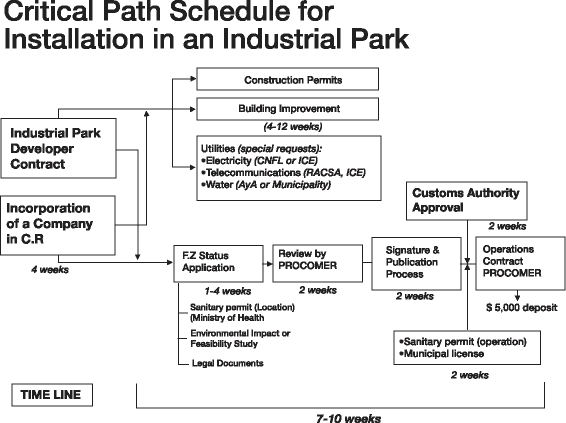
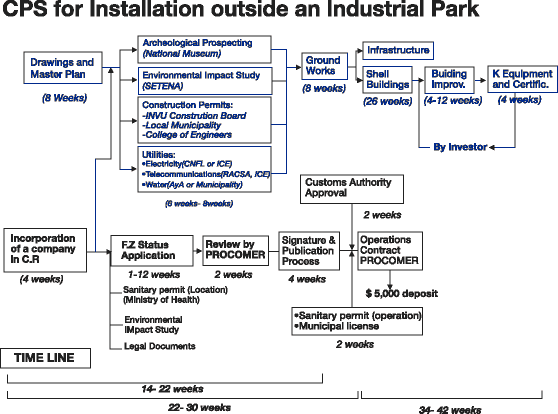
You are in good company
Companies whose names are synonymous with high quality standards already have factories, assembly plants or service operations in Costa Rica. They represent the full spectrum of business, commerce, services, agriculture and manufacturing.
The following are some international manufacturing and service companies established in Costa Rica:
- INTEL
- Bourns
- C & K Components
- Panduit Inc.
- Reliability Inc.
- Sawtek
- Remec
- EMC
- Merrimac.
- AETEC
- Agilent-HP
- DEK
- Pycon
- Babyliss / Conair
- Hitachi
- Sylvania
- Panasonic
- Sykes
- Microsoft
- Western Union
- Procter & Gamble
- Roche
- Baxter
- Abbott Laboratories
- DeRoyal
- Merck Sharp & Dohme
- Bayer
- Cyanamid
- Novartis
- HB Fuller
- Bridgestone - Firestone
- Alcoa
- Ikor
- Levi's
- Sara Lee / Bali
- Warnaco
- Wm. Carter
And many more...
Copyright 1996-2004
Note: The above information is not to be used for any other purpose other than private study, research, criticism or review. Thank you.

